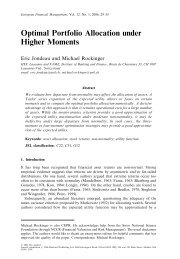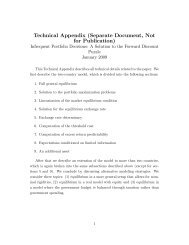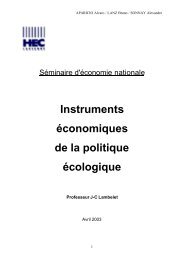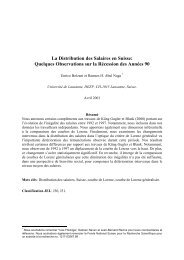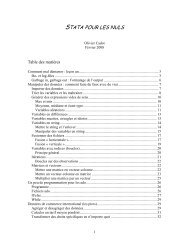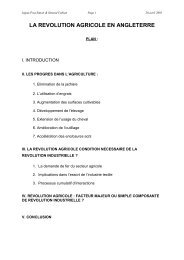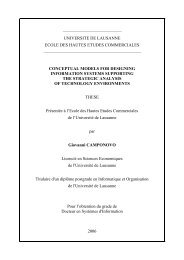The Business Model Ontology - a proposition in a design ... - HEC
The Business Model Ontology - a proposition in a design ... - HEC
The Business Model Ontology - a proposition in a design ... - HEC
Create successful ePaper yourself
Turn your PDF publications into a flip-book with our unique Google optimized e-Paper software.
<strong>The</strong> <strong>Bus<strong>in</strong>ess</strong> <strong>Model</strong> <strong>Ontology</strong> - a <strong>proposition</strong> <strong>in</strong> a <strong>design</strong> science approach<br />
role <strong>in</strong> public-sector organizations but also applies to the private sector.<br />
Table 6: Weill and Vitale’s (2001) atomic bus<strong>in</strong>ess models<br />
For Rappa (2001) a bus<strong>in</strong>ess model spells-out how a company makes money by specify<strong>in</strong>g where it is<br />
positioned <strong>in</strong> the value cha<strong>in</strong>. His classification scheme consists of n<strong>in</strong>e generic forms of e-bus<strong>in</strong>ess<br />
models, which are Brokerage, Advertis<strong>in</strong>g, Infomediary, Merchant, Manufacturer, Affiliate,<br />
Community, Subscription and Utility (see Table 7). <strong>The</strong>se generic models essentially classify<br />
companies among the nature of their value <strong>proposition</strong> or their mode of generat<strong>in</strong>g revenues (e.g.<br />
advertis<strong>in</strong>g, subscription or utility model).<br />
Type of <strong>Model</strong> Subcategories Description<br />
Brokerage<br />
<strong>Model</strong><br />
Advertis<strong>in</strong>g<br />
<strong>Model</strong><br />
Infomediary<br />
<strong>Model</strong><br />
Merchant<br />
<strong>Model</strong><br />
Manufacturer<br />
<strong>Model</strong><br />
Affiliate <strong>Model</strong><br />
Community<br />
<strong>Model</strong><br />
Subscription<br />
<strong>Model</strong><br />
Utility <strong>Model</strong><br />
Marketplace Exchange, <strong>Bus<strong>in</strong>ess</strong><br />
Trad<strong>in</strong>g Community, Buy/ Sell<br />
Fulfilment, Demand Collection<br />
System, Auction Broker, Transaction<br />
Broker, Bounty Broker, Distributor,<br />
Search Agent, Virtual Mall<br />
Portal, Personalised Portal, Niche<br />
Portal, Classifieds, Registered Users,<br />
Query-based Paid Placement,<br />
Contextual Advertis<strong>in</strong>g<br />
Advertis<strong>in</strong>g Networks, Audience<br />
Measurement Services, Incentive<br />
Market<strong>in</strong>g, Metamediary<br />
Virtual Merchant, Catalog Merchant,<br />
Click and Mortar, Bit Vendor<br />
Brand Integrated Content<br />
Voluntary Contributor <strong>Model</strong>,<br />
Knowledge Networks<br />
Content Services, Person-to-Person<br />
Network<strong>in</strong>g Services, Trust Services,<br />
Internet Service Providers<br />
<strong>The</strong>y br<strong>in</strong>g buyers and sellers together and<br />
facilitate transactions. Usually, a broker<br />
charges a fee or commission for each<br />
transaction it enables.<br />
<strong>The</strong> broadcaster, <strong>in</strong> this case a web site,<br />
provides content (usually for free) and services<br />
(like email, chat, forums) mixed with<br />
advertis<strong>in</strong>g messages <strong>in</strong> the form of banner<br />
ads. <strong>The</strong> banner ads may be the major or sole<br />
source of revenue for the broadcaster. <strong>The</strong><br />
broadcaster may be a content creator or a<br />
distributor of content created elsewhere.<br />
Some firms function as <strong>in</strong>fomediaries<br />
(<strong>in</strong>formation <strong>in</strong>termediaries) by either<br />
collect<strong>in</strong>g data about consumers or collect<strong>in</strong>g<br />
data about producers and their products.<br />
Wholesalers and retailers of goods and<br />
services.<br />
Manufacturers can reach buyers directly and<br />
thereby compress the distribution channel.<br />
<strong>The</strong> affiliate model provides purchase<br />
opportunities wherever people may be surf<strong>in</strong>g.<br />
It does this by offer<strong>in</strong>g f<strong>in</strong>ancial <strong>in</strong>centives (<strong>in</strong><br />
the form of a percentage of revenue) to<br />
affiliated partner sites. <strong>The</strong> affiliates provide<br />
purchase-po<strong>in</strong>t click-through to the merchant<br />
via their web sites.<br />
<strong>The</strong> community model is based on user<br />
loyalty. Users have a high <strong>in</strong>vestment <strong>in</strong> time<br />
and emotion <strong>in</strong> the site. In some cases, users<br />
are regular contributors of content and/or<br />
money.<br />
Users are charged a periodic – daily, monthly<br />
or annual – fee to subscribe to a service.<br />
<strong>The</strong> utility model is based on meter<strong>in</strong>g usage,<br />
or a pay as you go approach. Unlike subscriber<br />
services, metered services are based on actual<br />
usage rates<br />
Table 7: Rappa’s (Rappa 2001) classification scheme<br />
Applegate (Applegate 2001) identifies four categories for digital bus<strong>in</strong>ess models, for which she gives<br />
a number of examples (see Table 8).<br />
29




